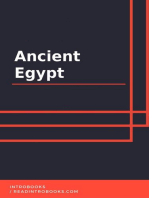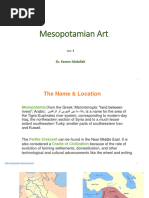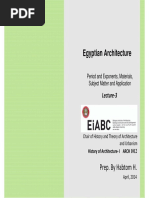0 ratings0% found this document useful (0 votes)
36 viewsAncient
Ancient
Uploaded by
Gerson Paul BangoyUruk was an important ancient Mesopotamian city founded around 4500 BCE that is most famous as the home of the epic of Gilgamesh. It was a center of early civilization and was the first to develop the writing system of cuneiform around 3200 BCE. Cuneiform was used by later Mesopotamian civilizations like the Sumerians, Akkadians, Babylonians, Assyrians, and others until being replaced by an alphabet after 100 BCE.
Copyright:
© All Rights Reserved
Available Formats
Download as DOCX, PDF, TXT or read online from Scribd
Ancient
Ancient
Uploaded by
Gerson Paul Bangoy0 ratings0% found this document useful (0 votes)
36 views4 pagesUruk was an important ancient Mesopotamian city founded around 4500 BCE that is most famous as the home of the epic of Gilgamesh. It was a center of early civilization and was the first to develop the writing system of cuneiform around 3200 BCE. Cuneiform was used by later Mesopotamian civilizations like the Sumerians, Akkadians, Babylonians, Assyrians, and others until being replaced by an alphabet after 100 BCE.
Original Description:
Uruk
Copyright
© © All Rights Reserved
Available Formats
DOCX, PDF, TXT or read online from Scribd
Share this document
Did you find this document useful?
Is this content inappropriate?
Uruk was an important ancient Mesopotamian city founded around 4500 BCE that is most famous as the home of the epic of Gilgamesh. It was a center of early civilization and was the first to develop the writing system of cuneiform around 3200 BCE. Cuneiform was used by later Mesopotamian civilizations like the Sumerians, Akkadians, Babylonians, Assyrians, and others until being replaced by an alphabet after 100 BCE.
Copyright:
© All Rights Reserved
Available Formats
Download as DOCX, PDF, TXT or read online from Scribd
Download as docx, pdf, or txt
0 ratings0% found this document useful (0 votes)
36 views4 pagesAncient
Ancient
Uploaded by
Gerson Paul BangoyUruk was an important ancient Mesopotamian city founded around 4500 BCE that is most famous as the home of the epic of Gilgamesh. It was a center of early civilization and was the first to develop the writing system of cuneiform around 3200 BCE. Cuneiform was used by later Mesopotamian civilizations like the Sumerians, Akkadians, Babylonians, Assyrians, and others until being replaced by an alphabet after 100 BCE.
Copyright:
© All Rights Reserved
Available Formats
Download as DOCX, PDF, TXT or read online from Scribd
Download as docx, pdf, or txt
You are on page 1of 4
Uruk was one of the
most important cities (at
one time, the most
important) in
ancient Mesopotamia.
According to the Sumerian
King List, it was founded by
King Enmerkar sometime
around 4500 BCE. Located in
the southern region
of Sumer(modern day
Warka, Iraq), Uruk was known in the Aramaic language
as Erech which, it is believed, gave rise to the modern name for the
country of Iraq (though another likely derivation is Al-Iraq, the Arabic
name for the region of Babylonia). The city of Uruk is most famous for its
great king Gilgamesh and the epic tale of his quest for immortality but also
for a number of `firsts’ in the development of civilization which occurred
there.
Cuneiform is a system of writing first
developed by the
ancient Sumerians of Mesopotamia c. 3500-
3000 BCE. It is considered the most significant
among the many cultural contributions of the
Sumerians and the greatest among those of the
Sumerian city of Uruk which advanced the
writing of cuneiform c. 3200 BCE. The name
comes from the Latin word cuneus for 'wedge'
owing to the wedge-shaped style of writing. In
cuneiform, a carefully cut writing implement
known as a stylus is pressed into soft clay to
produce wedge-like impressions that represent word-signs (pictographs)
and, later, phonograms or `word-concepts' (closer to a modern-day
understanding of a `word'). All of the great Mesopotamian civilizations
used cuneiform until it was abandoned in favour of the alphabetic script at
some point after 100 BCE, including:
Sumerians
Akkadians
Babylonians
Elamites
Hatti
Hittites
Assyrians
Hurrians
The first successful efforts to control the
flow of water were made in Mesopotamia and
Egypt, where the remains of the prehistoric
irrigation works still exist. In ancient Egypt,
the construction of canals was a major
endeavor of the pharaohs and their servants,
beginning in Scorpio's time. One of the first
duties of provincial governors was the digging
and repair of canals, which were used to flood
large tracts of land while the Nile was flowing
high. The land was checkerboarded with small basins, defined by a
system of dikes . Problems regarding the uncertainty of the flow of
the Nile were recognized. During very high flows, the dikes were
washed away and villages flooded, drowning thousands. During low
flows, the land did not receive water, and no crops could grow. In
many places where fields were too high to receive water from the
canals, water was drawn from the canals or the Nile directly by a
swape or a shaduf. These consisted of a bucket on the end of a cord
that hung from the long end of a pivoted boom, counterweighted at
the short end. The building of canals continued in Egypt throughout
the centuries. The Sumerians in southern Mesopotamia built city
walls and temples and dug canals that were the world's first
engineering works. It is also of interest that these people, from the
beginning of recorded history, fought over water rights. Irrigation
was extremely vital to Mesopotamia, Greek for "the land between
the rivers." Flooding problems were more serious in Mesopotamia
than in Egypt because the Tigris and Euphrates carried several times
more silt per unit volume of water than the Nile. This resulted in
rivers rising faster and changing their courses more often in
Mesopotamia.
The use of cosmetics in Egypt varied slightly
between social classes, where more make-up
was worn by higher class individuals as
wealthier individuals could afford more
cosmetics. Although there was no prominent
difference between the make-up styles of the
upper and lower class, noble women were
known to pale their skin using creams and
powders. This was due to pale skin being a sign
of nobility (especially in the Late and Graeco-
Roman Periods of Egypt) as lighter skin meant
less exposure to the sun whereas dark skin was
associated with the lower class who tanned
while taking part in menial labor such as
working in the fields. Thus, paler skin represented the non-working
noble class, as noble women would not work in the sun.
Upper-class Egyptian men and women
considered wigs an essential part of
their wardrobe. Wearing a wig
signaled a person's rank in Egyptian
society. Although a shaved head was
a sign of nobility during most of the
Egyptian kingdoms, the majority of
Egyptians kept their heads covered.
Wigs were worn in place of
headdresses or, for special occasions,
with elaborate headdresses. Egyptian
law prohibited slaves and servants
from shaving their heads or wearing
wigs.
The base of an Egyptian wig was a fiber-netting skullcap, with
strands of human hair, wool, flax, palm fibers, felt, or other materials
attached. The wig hair often stuck straight out from the skullcap,
creating large, full wigs that offered wearers protection from the
heat of the sun. Most often black, wigs were also other colors.
Queen Nefertiti, who lived during the fourteenth century b.c.e., was
known for wearing dark blue wigs, and festive wigs were sometimes
gilded, or thinly coated in gold.
A water clock or clepsydra (Greek κλεψύδρα from κλέπτειν kleptein,
'to steal'; ὕδωρ hydor, 'water') is any timepiece by which time is
measured by the regulated flow of liquid into
(inflow type) or out from (outflow type) a
vessel, and where the amount is then
measured.
Water clocks are one of the oldest time-
measuring instruments.[1] They were invented
in ancient Egypt. The bowl-shaped outflow is
the simplest form of a water clock and is
known to have existed in Babylon and
in Egypt around the 16th century BC. Other
regions of the world,
including India and China, also have early
evidence of water clocks, but the earliest
dates are less certain. Some authors,
however, claim that water clocks appeared in
China as early as 4000 BC.[2]
You might also like
- Historical Context of The Epic of GilgameshDocument2 pagesHistorical Context of The Epic of GilgameshMarcus Hearne0% (1)
- DEED OF ABSOLUTE SALE - ltvtpmpc.12.2017Document2 pagesDEED OF ABSOLUTE SALE - ltvtpmpc.12.2017black stalker100% (1)
- WL IiDocument7 pagesWL Iijelostamariac15No ratings yet
- Ucsp Early-CivilizationsDocument14 pagesUcsp Early-CivilizationsApsimachiaNo ratings yet
- History of Egypt: The King." Wall Paintings and Objects From TombsDocument3 pagesHistory of Egypt: The King." Wall Paintings and Objects From TombsTeacher AnnaNo ratings yet
- L1 (Ancient Mesopotamia and Egypt)Document2 pagesL1 (Ancient Mesopotamia and Egypt)Rabbie Lyca P. BelirNo ratings yet
- ,technology and SocietyDocument4 pages,technology and SocietyDianne AysonNo ratings yet
- Scites 1Document7 pagesScites 1Arlene DeppNo ratings yet
- EgytianDocument6 pagesEgytianWholesome BlogsNo ratings yet
- Project StsDocument26 pagesProject Stsadnlnz.814No ratings yet
- Historical Antecedents in Which Social Considerations Changed The Course of Science and Technology 7Document84 pagesHistorical Antecedents in Which Social Considerations Changed The Course of Science and Technology 7angeleustaquio5No ratings yet
- CivilizationDocument14 pagesCivilizationDea WihelminaNo ratings yet
- LESSON 2B: Ancient Civilization: (Greek, Roman, and Egyptian)Document7 pagesLESSON 2B: Ancient Civilization: (Greek, Roman, and Egyptian)Kenji ToleroNo ratings yet
- LESSON 2 - ma'amDocument43 pagesLESSON 2 - ma'amkazeyo1023No ratings yet
- Sumer - World HistoryDocument7 pagesSumer - World HistorySvetlana HikariNo ratings yet
- PAGLANGAN Jay Akbar S. 2BSE A - CHAPTER 2 EGYPT GIFT OF THE NILEDocument14 pagesPAGLANGAN Jay Akbar S. 2BSE A - CHAPTER 2 EGYPT GIFT OF THE NILEJay-akbar PaglanganNo ratings yet
- Ancient Middle East and EgyptDocument50 pagesAncient Middle East and EgyptDokter AnestesiNo ratings yet
- Chapter 1 Historical AntecedentDocument52 pagesChapter 1 Historical AntecedentRhen Tomboc Olasiman-MateoNo ratings yet
- STS Lesson 2&3Document57 pagesSTS Lesson 2&3Liza MaryNo ratings yet
- Exp Egyptian AchievementsDocument7 pagesExp Egyptian Achievementsapi-214066507No ratings yet
- Module 2-Historical Antecedents in The Course of Science and TechnologyDocument32 pagesModule 2-Historical Antecedents in The Course of Science and TechnologyCharles CabarlesNo ratings yet
- Science, Technology and SocietyDocument22 pagesScience, Technology and SocietyMae Aires GaleNo ratings yet
- MESOPOTAMIADocument22 pagesMESOPOTAMIAar.hammadhameedNo ratings yet
- مودةDocument8 pagesمودةkamilakmal787No ratings yet
- History Class 12 - Module 2-02-12-2014 MesopotamiaDocument30 pagesHistory Class 12 - Module 2-02-12-2014 MesopotamiaNipun GeorgeNo ratings yet
- Name: Date:: Caption: This Wall Painting From AncientDocument6 pagesName: Date:: Caption: This Wall Painting From Ancientashbyrushwaya321No ratings yet
- 3 - Mesopotamian ArtDocument62 pages3 - Mesopotamian Artahmedessamaee654No ratings yet
- LESSON 2Document6 pagesLESSON 2kazeyo1023No ratings yet
- Ancient Civilizations SummaryDocument47 pagesAncient Civilizations SummaryosshiieNo ratings yet
- G1 SumerianCivilizationDocument8 pagesG1 SumerianCivilizationfernando.gl559No ratings yet
- Western Civilizations HST 102 Design Project - Sharon MwangiDocument20 pagesWestern Civilizations HST 102 Design Project - Sharon Mwangisharonmwangi97No ratings yet
- Ancient MesopotamiaDocument6 pagesAncient MesopotamiaJacob Kahle HortonNo ratings yet
- Nile Valley CivilizationDocument43 pagesNile Valley CivilizationnishantmmNo ratings yet
- Hoa Egyptian ArchitectureDocument23 pagesHoa Egyptian ArchitectureAlexandra PatayanNo ratings yet
- IS04 - Ancient Egypt EmpireDocument37 pagesIS04 - Ancient Egypt EmpireNur HidayahNo ratings yet
- Mesopotamia: Code of Hammurabi (Codex Hammurabi) Is A Well-Preserved AncientDocument4 pagesMesopotamia: Code of Hammurabi (Codex Hammurabi) Is A Well-Preserved Ancientapi-26011047No ratings yet
- Historical Antecedents in The Course of Science and TechnologyDocument22 pagesHistorical Antecedents in The Course of Science and TechnologyAngel ni bubblesNo ratings yet
- Sumerian CivilizationDocument12 pagesSumerian Civilizationmohamedalyaan311No ratings yet
- Chapter 2 Section 1Document11 pagesChapter 2 Section 1sylervghimendouga03No ratings yet
- Ancient Egypt: Early SettlementDocument26 pagesAncient Egypt: Early SettlementChristopher David HeananNo ratings yet
- The Uruk Period: Uruk Cities Mesopotamia Sumerian SumerDocument5 pagesThe Uruk Period: Uruk Cities Mesopotamia Sumerian SumerStefan MihajlovicNo ratings yet
- 202003261536151812anil Kumar Ancient Egypt1Document23 pages202003261536151812anil Kumar Ancient Egypt1ShreyaNo ratings yet
- Egyptian VocabularyDocument8 pagesEgyptian VocabularyKantnatt CharatcharoenwitthayaNo ratings yet
- INDIA AND THE WORLD. History TimelineDocument62 pagesINDIA AND THE WORLD. History Timelineworld civilization100% (2)
- StsDocument27 pagesStsPj RamosNo ratings yet
- History of WritingDocument7 pagesHistory of WritingJohn Paul Dela CruzNo ratings yet
- Historical AntecedentsDocument11 pagesHistorical Antecedentselvincastardo11No ratings yet
- MesopotamiaDocument35 pagesMesopotamiaapi-299513272No ratings yet
- The Epic of GilgameshDocument11 pagesThe Epic of GilgameshIJ100% (1)
- The Early Civilization in AsiaDocument32 pagesThe Early Civilization in Asiakimflores100% (10)
- t-h-299-history-knowledge-organiser-ancient-egypt-uks2_ver_2Document2 pagest-h-299-history-knowledge-organiser-ancient-egypt-uks2_ver_2mrssmartbee7No ratings yet
- Lecture 3 - History and Theory of Architecture - EgyptDocument57 pagesLecture 3 - History and Theory of Architecture - EgyptMer'at LoulNo ratings yet
- Mesopotamian CivilisationDocument13 pagesMesopotamian CivilisationMini GuptaNo ratings yet
- Old Civilizations and Their ComparisonsDocument2 pagesOld Civilizations and Their Comparisonsvien2xboromeoNo ratings yet
- Making and Unmaking of MesopotamiaDocument8 pagesMaking and Unmaking of MesopotamiaTanuj Sharma100% (5)
- Intro To Travel and Tour Lesson #2Document25 pagesIntro To Travel and Tour Lesson #2Jayson CabanillaNo ratings yet
- Starvacation in Ancient EgyptDocument1 pageStarvacation in Ancient EgyptStar VacationsNo ratings yet
- Pub - Ancient Egypt Ancient Civilizations PDFDocument89 pagesPub - Ancient Egypt Ancient Civilizations PDFjanosuke100% (2)
- Hatisa Fluorescent Tube Light?: Filipino Inventor InventionDocument1 pageHatisa Fluorescent Tube Light?: Filipino Inventor InventionGerson Paul BangoyNo ratings yet
- Study of 7 Literacies: Multicultural/Globalization LiteracyDocument2 pagesStudy of 7 Literacies: Multicultural/Globalization LiteracyGerson Paul BangoyNo ratings yet
- Health Benefits of Coconut Milk23Document6 pagesHealth Benefits of Coconut Milk23Gerson Paul BangoyNo ratings yet
- Bati Ka Ug NaungDocument8 pagesBati Ka Ug NaungGerson Paul BangoyNo ratings yet
- Literacy Be Used in The Classroom?Document6 pagesLiteracy Be Used in The Classroom?Gerson Paul BangoyNo ratings yet
- Alponsa GwapoDocument3 pagesAlponsa GwapoGerson Paul BangoyNo ratings yet
- AdingDocument5 pagesAdingGerson Paul BangoyNo ratings yet
- Fabrication of CopperDocument4 pagesFabrication of CopperGerson Paul BangoyNo ratings yet
- The Indian Mythology 1Document1 pageThe Indian Mythology 1Gerson Paul BangoyNo ratings yet
- Tricycle: Motorized Tricycles, or Simply Tricycles (Known in The Rest of The World As A Motorcycle and Sidecar), AreDocument2 pagesTricycle: Motorized Tricycles, or Simply Tricycles (Known in The Rest of The World As A Motorcycle and Sidecar), AreGerson Paul BangoyNo ratings yet
- Vapor Compression Refrigeration SystemDocument6 pagesVapor Compression Refrigeration SystemGerson Paul BangoyNo ratings yet
- Globalization: Karina B. Cabinalan Bse-1CDocument1 pageGlobalization: Karina B. Cabinalan Bse-1CGerson Paul BangoyNo ratings yet
- Inbound 7103591957311566080Document3 pagesInbound 7103591957311566080fon2mel360No ratings yet
- Samba Financial GroupDocument17 pagesSamba Financial GroupNoor Ul AinNo ratings yet
- Business Plan Talha & Co A Trading BusinessDocument14 pagesBusiness Plan Talha & Co A Trading BusinessRana Haris -280No ratings yet
- Strippers Are Doing It For ThemselvesDocument13 pagesStrippers Are Doing It For Themselves5ongNo ratings yet
- Oil Mist Separator PDFDocument2 pagesOil Mist Separator PDFavm4343No ratings yet
- Salisbury F.S., Mat Tingly, H., The Reign of Trajan DeciusDocument24 pagesSalisbury F.S., Mat Tingly, H., The Reign of Trajan Deciustheophylact100% (1)
- Talking About Movies & TV Conversation Cheat Sheet: Main DialogueDocument2 pagesTalking About Movies & TV Conversation Cheat Sheet: Main DialogueGaruda WLNo ratings yet
- ECO101 Problem Set 7 Questions Firm CostsDocument2 pagesECO101 Problem Set 7 Questions Firm CostsEshika SehgalNo ratings yet
- 10 Breakthrough Technologies 2024 (MIT TR)Document2 pages10 Breakthrough Technologies 2024 (MIT TR)Kuo Szu-WeiNo ratings yet
- 40 RabannaDocument43 pages40 RabannaRamzan ArshadNo ratings yet
- Les Détails de L'accord Entre Lottotech Et Le Gouvernement PDFDocument4 pagesLes Détails de L'accord Entre Lottotech Et Le Gouvernement PDFION NewsNo ratings yet
- How Receive Your Healing Excerpt E-BookDocument30 pagesHow Receive Your Healing Excerpt E-BookOlamide GodstarNo ratings yet
- Anuradha Mam, FrankestineDocument17 pagesAnuradha Mam, FrankestineSidra FatimaNo ratings yet
- International Financial Markets-Chapter 8Document12 pagesInternational Financial Markets-Chapter 8Marlou AbejuelaNo ratings yet
- Rules and Regulations Governing The Licensing of Meat Shop in CoiambatoreDocument4 pagesRules and Regulations Governing The Licensing of Meat Shop in CoiambatoreKrishnan JayaramanNo ratings yet
- Datuk HJ Ishak Bin Ismail V Kenanga Investment Bank BHD & OrsDocument29 pagesDatuk HJ Ishak Bin Ismail V Kenanga Investment Bank BHD & OrsAmila AhmadNo ratings yet
- Tourism and PromotionDocument40 pagesTourism and PromotionMary Jane Blanco FioNo ratings yet
- MRivera MGT361 Case Study #1Document5 pagesMRivera MGT361 Case Study #1Manuel RiveraNo ratings yet
- Conjeevaram: The Sculpted Stories of SilkDocument6 pagesConjeevaram: The Sculpted Stories of SilkAbhishek ParabNo ratings yet
- Gender Stereotypes in Fairy TalesDocument61 pagesGender Stereotypes in Fairy TalesChristina ChNo ratings yet
- ANARDE & Two Othrs Vs A.G & UNRADocument16 pagesANARDE & Two Othrs Vs A.G & UNRANamutosi ImmaculateNo ratings yet
- React Context APIDocument16 pagesReact Context APIkrishnvamsiNo ratings yet
- State Street RFP PDFDocument31 pagesState Street RFP PDFRamesh KumarNo ratings yet
- International PoetsDocument13 pagesInternational PoetsIrishNo ratings yet
- Marketing Lesson 6Document6 pagesMarketing Lesson 6nataliaslife23No ratings yet
- RRB NTPC E: Study Material For General AwarenessDocument4 pagesRRB NTPC E: Study Material For General AwarenessPrasun bairagiNo ratings yet
- Police LeadershipDocument186 pagesPolice Leadershipsi_imannn100% (2)
- Euphoria 103 Made You Look 2019Document72 pagesEuphoria 103 Made You Look 2019Ahmed SamehNo ratings yet
- 147 Sow in Tears Reap in JoyDocument11 pages147 Sow in Tears Reap in Joynazareo1963No ratings yet





































































































